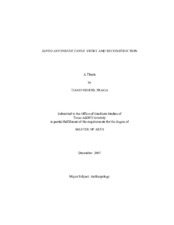| dc.description.abstract | Buy a puzzle, assemble it, and destroy its original box. Take the puzzle, go to a lake,
throw the puzzle in the lake, and leave it for a few weeks. Return to the lake and try to
rebuild the puzzle from the remaining pieces. Such is the challenge of the research goals
presented on this abstract – the reconstruction of a Portuguese frigate, Santo Antonio de
Tanná, from its submerged remains. This thesis focuses on the mechanisms of
reconstructing the ship, including the thought process, new computer tools, and
imagination required for an archaeologist to be a detective of lost eras.
The main objective was to understand the construction of a late Seventeenth-century
Portuguese frigate. Frigates were responsible for patrolling the seas, intercepting fastmoving
vessels, re-supplying military trading stations, and protecting trade routes. The
existence of Portuguese frigates was known from historical records, but Santo Antonio
de Tanná is the only frigate identified in the archaeological record. As such, its
reconstruction should enable scholars to better understand the actual capabilities of
seventeenth century frigates.A particular challenge in this study was ascertaining the manner in which Santo Antonio
de Tanná’s construction reflected the state of affairs of the Portuguese trade network.
Although their construction methods were advanced, the Portuguese adopted a
shipbuilding design that was not able to compete as well in the new conditions of a
changing global context. This study clearly demonstrate that cargo capacity was given
greater emphasis than either speed or maneuverability, illustrating the on-going necessity
of the Portuguese to build military ships with cargo capacity sufficient for minimal trade,
even at the expense of speed.
These were just the first steps in terms of what could be learned from the reconstruction.
The best method to understand the ship, a three-dimensional object, was to recreate it
into a three-dimensional environment in order to create a more accurate model. The
resulting model permitted research to extend beyond the limits of the individual line
drawings through the added benefit of being able to calculate hydrodynamics, sailing
characteristics, and other data based on the ship’s morphology. | en |


